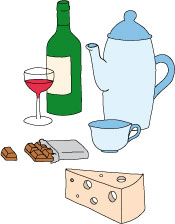Definition of Migraine

Many foods can provoke a migraine
attack.Culprits are often red wine,
coffee, cheese or chocolate but it
varies greatly from person to person.
Migraine is a severe form of headache. In contrast to the general tension headache migraine is characterized by:
- An attack lasts between 4 and 72 hours.
- The headache is severe, unilateral, pulsating (pounding) or is getting worse by physical activity.
- There is sensitivity to light and sound with nausea or vomiting.
Migraine is a common disease. 25% of women and almost 10% of men will experience migraine attacks throughout their lives. Migraine usually starts in puberty and attacks become more frequent until 40-50 years of age, after which they again become rarer.
Migraine is divided into two types: Common migraine and migraine with aura. Aura is the term used to describe a range of symptoms that occur up to one hour before a migraine attack. These symptoms also last under an hour, usually 10-30 minutes. When the aura symptoms are gone and the headache begins, the two migraine types are alike.
Causes of Migraines
The exact cause of migraine is is not known but for migraine with aura is has been documented that the brain blood vessels contract during the aura phase and expand during the headache phase. This is used in the treatment of migraine. In the vast majority (around 80%) migraine is hereditary, but besides also a wide array of external factors that can trigger an attack:
- Disruptions of sleep patterns.
- Food products (cheese, chocolate, coffee, red wine).
- Stress.
- Menstrual and other hormonal disorders.
However, it is individual from person to person, what triggers a migraine attack.
Symptoms of migraine
Before an attack (with or without aura), the patient might have symptoms that signal that an attack is underway. This may for example be hunger, urge to yawn, tiredness, restlessness or crying. In addition, the following symptoms appear during aura and headache:
Aura symptoms:
Common for these symptoms is that they are moving across parts of the body. This has also given the name migraine to the disease (migrate = to move)
- Visual disturbances. This is by far the most common aura symptom, and it appears as a small flickering area in the middle of the field of vision, which slowly spreads to one side as a semicircle. Within the half circle, there is a blind area. When the circle reaches the edge of the field of vision, the sight returns. The symptom can be quite intimidating if you do not know what this is about, but it is completely harmless.
- Sensory disturbances. These usually start in the face or in a hand or finger and then spread across the face or an arm and disappear by turning into visual disturbances after approx. twenty minutes.
- Other disorders. This may be the paralysis of an arm or a leg or difficulty speaking. In older people these symptoms can also be signs of stroke.
Headache symptoms (both in migraine with and without aura)
- Severe headache, usually on one side of the head.
- The headache is usually pulsating/pounding.
- Aggravation from movement and physical activity.
- Hypersensitivity to light and sound (to lie silently in a dark room is usually most comfortable).
- Nausea, vomiting or diarrhea.
In migraine with aura the attacks are rarer, often occurring only a few times a year. Here the headache is also often more powerful than is the case in migraine without aura.
Common migraine is more frequent. Up to several attacks a month is not uncommon.
Precautions and diagnosis
If headache cannot be remedied with ordinary headache medication it might be migraine. You should contact your doctor, who can usually make the diagnosis based on typical symptoms. Patients might identify the causes leading to attacks and avoid them. A headache/migraine diary where you write about attacks and what you were doing or consuming in the run-up to an attack might be a very useful tool to avoid or limit migraine attacks. Contraceptive pills can also trigger migraine attacks. It is important to remember that migraine is not a dangerous condition despite its unpleasant character.
Treatment of migraine
The treatment of migraine consists of two things, attack treatment and prevention of new attacks.
Attack Treatment
For migraine without aura, attacks can sometimes be treated with common pain killer, such as Panodil, Aspirin or nausea medication. Otherwise, the most common treatment is vascular contracting medication. There are many different types, and perhaps different types should be tested to obtain the best result. However, caution must prevail and the medication only taken in consultation with a doctor as the treatment itself might lead to severe headache if taken too frequently or in too larges doses.
Preventing attacks
If you have more than two attacks per month, and if attacks are so powerful that they are debilitating preventive treatment might become necessary. This may for example be beta-blockers. Preventive treatment should be closely followed by the general practitioner.
Outlook
Migraine is a volatile and very individual disease but it usually recedes with age.
For more information, read the articles:
Food and migraine
Hormones and migraines
Definition
Migraine is a severe form of headache. In contrast to the general tension headache migraine is characterized by:
Read this article in Danish
Przeczytaj ten artykuł w języku polskim
|